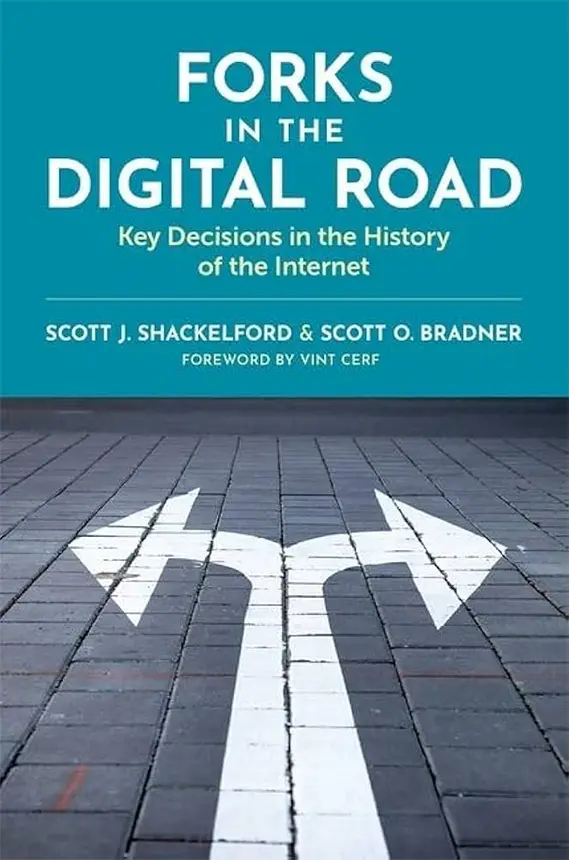


|
||
|
||

At first glance, this book looks like another history of the Internet, but it is much, much more. The authors use their engineering and scholarly understanding of what constitutes Internet history to identify forks in the digital road and key past decisions that shaped the Internet’s path.
The first part of the book maps out the core technical and policy decisions that created the Internet. We find many familiar names and milestones, and the authors offer insights into how they came about and connect with one another. The second part uses this general map to look at 5 key decisions that shaped the Internet by asking the question we often ask ourselves: “What if? What if encryption had been built into the Internet’s architecture from the beginning? What if Section 230, which shields Internet platforms from civil liability, had taken a different form? What if Tim-Berners Lee had taken the advice of counsel and patented the World Wide Web? And what if the U.S. government had not helped to establish the Internet Corporation for Assigned Names and Numbers (ICANN) in 1998 or elected not to launch a new era of cyber conflict in 2006?”
To answer the questions and others related to them, the authors avoid speculation and bring forward reasoned and convincing arguments. The real insights the book provides derive from its discussion where we, with hindsight, would have ended up had we taken the other direction. Exploration of the paths not taken helps us to realize how well-intentioned and considered principles and convictions, given time and circumstances, can result in the opposite of the intended outcome, for example, in the case of freedom and regulation. Freedom, as exemplified by the postulate of “unregulated innovation,” can result in servitude of the weak, whilst restrictions, as exemplified by “acceptable use policies,” AUPs, can free the oppressed to flourish. The lesson learned here is:” Beware of dogmas. Think!”
In the third part, the book takes stock and draws conclusions. The authors skip and do not enter or recall the past and present odious quack Internet Governance has increasingly become since the late 1990’s. Instead, they ask for the Internet We Deserve. They also offer their insights on the significance and prospects of cyber peace and equitable Internet governance, which are imperfect but nevertheless worthy of thoughtful consideration. “Polycentric Governance,” “a multilevel, multipurpose, multifunctional, and multisectoral model, championed besides others by Nobel Laureate Professor Elinor Ostrom. A “polycentric approach recognizes that diverse organizations working at multiple levels can create different types of policies that can increase levels of cooperation and compliance, enhancing “flexibility across issues and capability over time.”
The authors, in the spirit of Ostrom, ask for “more experimentation and less theorizing.” The authors undermine their own argument as the quality of the third chapter lets the reader ask for more, not less, theorizing to inform our current experimentations. The chapter encourages us to get back to the drawing board and redesign Internet governance before rebuilding it. If we take what the authors have to say seriously, the book itself will be seen in the future as a fork in the road. But since when does action necessarily follow reason?
The limitation and strength of the book is understanding what constitutes history. The author’s understanding is completely rational and reasonable. Still, the question of why one event should be included and not another lingers. Vint Cerf hints at this in the first paragraph of his Foreword. “No one’s sense of history is ever the same as another’s.” The truth of History is never absolute, and we can only try to get closer to it through dialogue, and that’s where polycentricity comes in. The book encouraged us to think twice and apply the insights of the past as we encounter today’s forks on the road. Will today’s choices lead us to the Internet we deserve or into the abyss? But that is, as the authors say: “...the subject of another book.”
PS: The book avoids the AI hype, which no publication about Cyberspace nowadays seems able to do without. In fact, AI is never mentioned. The authors trust in the reader’s ability to make up their own minds, which some readers, like the author of this review, deeply appreciate.
Sponsored byVerisign

Sponsored byRadix

Sponsored byIPv4.Global

Sponsored byWhoisXML API

Sponsored byVerisign

Sponsored byDNIB.com

Sponsored byCSC
